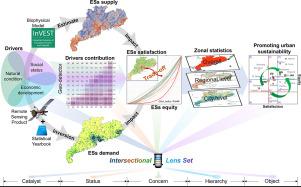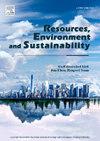Unveiling driving disparities between satisfaction and equity of ecosystem services in urbanized areas
IF 7.8
Q1 ENVIRONMENTAL SCIENCES
引用次数: 0
Abstract
Rapid urbanization intensifies the challenges of achieving satisfaction and equity in ecosystem services (ESs). Beginning with a theoretical overview, we identify five pivotal challenges in managing urban ESs, forming the basis for our integrative analysis. Employing a multi-level analytical perspective, our research quantifies ESs satisfaction through supply–demand ratios and evaluates ESs equity via supply–demand Gini coefficient. Simultaneously explored the driving force relationship between these two dimensions. This study uses Guangdong Province, a typical urbanized area in China, as a case study to assess the supply and demand relationships of four regulating ESs: water retention, soil retention, carbon storage, and water purification. Our results highlight the disparity in ESs management effectiveness across different scales while the overall assessments might suggest adequate or equitable ESs, localized assessments within cities and regions often uncover specific ESs issues. A pivotal aspect is that single-factor critical to ESs satisfaction or equity dimension may have limited or opposing importance in another, but interactive effects of multiple factors can effectively mitigate these divergent impacts through non-linear synergies. These insights not only reveal the multiplex impacts of natural–social–economic drivers on urban expansion but also guide the targeted development in different management scale, multi-dimensional management strategies to address these disparities. This approach enriches the discourse on sustainable urban development and provides a robust framework for addressing the nuanced challenges of urban ESs management.

揭示城市化地区生态系统服务的满意度和公平性之间的差异驱动因素
快速城市化加剧了实现生态系统服务(ES)的满意度和公平性的挑战。从理论概述开始,我们确定了管理城市生态系统服务的五个关键挑战,为我们的综合分析奠定了基础。我们的研究采用多层次分析视角,通过供需比率量化生态系统服务的满意度,并通过供需基尼系数评估生态系统服务的公平性。同时探讨了这两个维度之间的驱动力关系。本研究以中国典型的城市化地区广东省为例,评估了四种调节性生态系统的供需关系:水源涵养、土壤保持、碳储存和水净化。我们的研究结果凸显了不同尺度环境系统管理效果的差异,虽然整体评估可能表明环境系统充足或公平,但城市和区域内的局部评估往往会发现具体的环境系统问题。一个关键的方面是,对环境服务满意度或公平性至关重要的单一因素在另一个方面的重要性可能有限或相反,但多种因素的互动效应可以通过非线性协同作用有效缓解这些不同的影响。这些见解不仅揭示了自然-社会-经济驱动因素对城市扩张的多重影响,还指导了不同管理规模、多维管理策略的有针对性发展,以解决这些差异。这种方法丰富了关于城市可持续发展的论述,并为应对城市环境系统管理的微妙挑战提供了一个强有力的框架。
本文章由计算机程序翻译,如有差异,请以英文原文为准。
求助全文
约1分钟内获得全文
求助全文
来源期刊

Resources Environment and Sustainability
Environmental Science-Environmental Science (miscellaneous)
CiteScore
15.10
自引率
0.00%
发文量
41
审稿时长
33 days
 求助内容:
求助内容: 应助结果提醒方式:
应助结果提醒方式:


